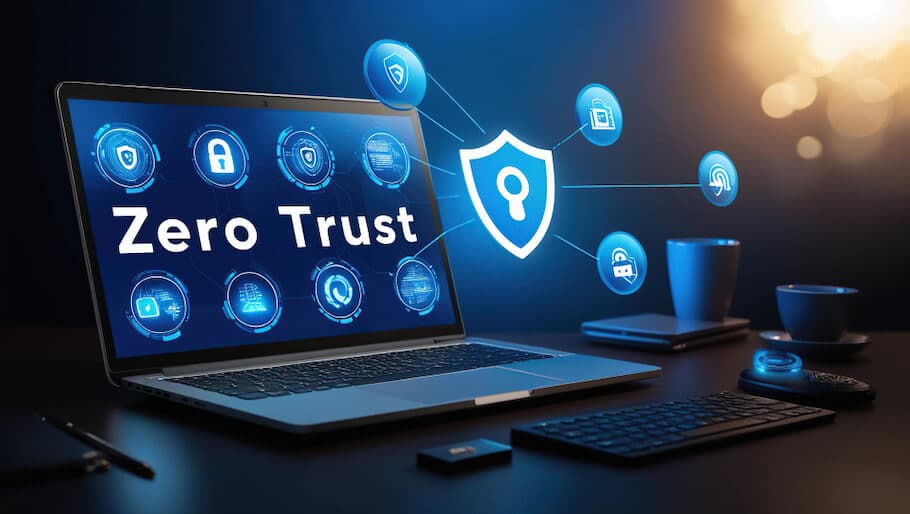Key Takeaway:
Strategically improving cybersecurity and effectively satisfying strict regulatory requirements are facilitated by adopting Zero Trust Security Principles (ZSP). Rethinking security, businesses might adopt a zero-trust architecture that constantly verifies rather than assumes trust. Encryption, micro-segmentation, continuous authentication, rigorous access control, and least privilege access build a strong foundation that complies with several standards, including GDPR, HIPAA, and PCI DSS. To adapt security tactics to different regulatory environments, firms must conduct risk assessments, carefully plan their designs, and check their progress continuously. Zero Trust is a proactive and resilient solution for today’s complex compliance needs in today’s fast-paced corporate world. Despite the hurdles, it offers heightened data security, secure access restrictions, and real-time monitoring.
Introduction

Companies in today’s complicated business climate must continually navigate a labyrinth of regulations. Compliance has become essential to company operations, encompassing data protection legislation and industry-specific rules.
Heavy penalties, legal action, and reputational harm are serious outcomes that can emerge from disregarding these rules and laws. Zero Trust Security Principles (ZSP) have arisen to guarantee compliance with regulatory obligations in such a context.
Mastering the Concepts of Zero Trust Security
As a security framework, Zero Trust questions the validity of the old perimeter-based approach. “Never trust, always verify” is the guiding philosophy of Zero Trust, in contrast to the conventional wisdom that holds that all network nodes are trustworthy. This means verification is necessary for everyone attempting to access resources, even within the organization’s network. No user or object is granted implicit confidence.
The Role of Zero Trust in Regulatory Compliance

Amidst the complex regulations, Zero Trust Security Principles (ZSP) stand out as a game-changer, reshaping how companies protect critical information. Zero Trust improves cybersecurity and becomes essential to keeping up with ever-changing legislation by adopting a “never trust, always verify” approach.
GDPR (General Data Protection Regulation)
“Data protection officers are becoming the ‘hottest properties’ in tech, but their true value lies in safeguarding sensitive information and building trust in a Zero Trust environment.” – Rise of the data protection officer, the hottest tech ticket in town. Reuters
Any business that deals with the private information of residents of the European Union must comply with the stringent guidelines laid out by the General Data Protection Regulation (GDPR). To ensure that only authorized persons can access and process personal data, Zero Trust is an essential component of GDPR compliance.
- Controls for Data Access: The least privileged access concept of zero trust aligns with the need to limit access to personal data imposed by GDPR. Companies can lessen the likelihood of illegal processing by granting access only to individuals who need it to do their jobs.
- Data Security with Encryption: Zero Trust’s focus on encryption aligns with the need to secure personal data, as emphasized by GDPR. Organizations can better meet the data protection requirements of GDPR by encrypting data while in motion and stored.
- Reactive Incident Management and Ongoing Monitoring: Zero Trust’s continuous authentication and monitoring capabilities make quickly recognizing and responding to possible data breaches easier. In line with GDPR, this ensures that the proper authorities are notified of data breaches promptly.
HIPAA (Health Insurance Portability and Accountability Act)
“Nearly 4,500 separate data breaches have compromised 500 or more patient records in the last 10 years.”
For this reason, the Healthcare Insurance Portability and Accountability Act (HIPAA) governs handling of sensitive medical data in the US. Zero Trust can help healthcare firms protect patient information and meet HIPAA regulations.
- Secure Data Access: The least privileged access mechanism of Zero Trust guarantees that no one other than authorized healthcare personnel can access patient records. In line with HIPAA’s requirement that only those with a legitimate need to know can access PHI, this is a good move!
- Data Security through Network Segmentation: Healthcare institutions can better protect their patients’ personal information from prying eyes by dividing their networks into smaller, more manageable pieces. The significance of safeguarding electronically protected health information is emphasized in HIPAA’s security regulation, which follows this.
- Secure Data Encryption: Healthcare businesses that handle protected health information (PHI) can greatly benefit from Zero Trust’s emphasis on encryption. Following HIPAA’s data protection standards, encrypting PHI helps shield patient information from prying eyes.
PCI DSS (Payment Card Industry Data Security Standard)
“As to Verizon’s most recent PCI DSS Compliance Report, there is a noticeable annual increase in the number of firms who achieve complete compliance during the intermediate assessment.”
Secure processing of payment card data is the goal of the Payment Card Industry Data Security Standard (PCI DSS). Businesses in the payment card sector can benefit from Zero Trust in their efforts to secure sensitive cardholder data and comply with PCI DSS regulations.
- Protected Cardholder Information: Only authorized staff can access cardholder data due to Zero Trust’s least privileged access. This complies with the PCI DSS regulations that restrict access to sensitive data.
- Network Segmentation for Payment Security: Companies can use micro-segmentation to secure their networks and the information stored on credit cards. This conforms to the standards set out by PCI DSS, which aim to limit the exposure of cardholder data by requiring networks to be segmented.
- Cardholder Data Encryption: The PCI DSS mandates encryption to safeguard cardholder data, which Zero Trust fully supports. Credit card details are further protected by encrypting data while it is in motion and stored.
Implementing Zero Trust for Regulatory Compliance

Success in today’s regulatory environment requires a strategy shift rather than focusing on compliance alone. By adopting Zero Trust Security Principles, companies can create a strong framework that can withstand rigorous regulatory standards.
- Conducting a Risk Assessment: Organizations should undertake a thorough risk assessment to determine the dangers they face and the regulatory requirements that apply to their business before implementing Zero Trust. The results of this evaluation will form the basis for a zero-trust architecture specifically designed to deal with compliance issues.
- Recognizing Needs for Regulation: Find out what rules, like GDPR, HIPAA, or PCI DSS, are unique to your company. Ascertain the most important regulations and their connections to data protection and access restrictions.
- Evaluating the Present Security Situation: Conduct an audit to find safety holes in your company’s security setup. Evaluate data security, incident response capabilities, and access restrictions to see their success.
- Creating an Architecture with Zero Trust: To create a Zero Trust architecture that complies with regulations, enterprises must first understand the security environment and their present security posture.
- Least Privilege Access Implementation: The notion of least privilege should inform the definition and enforcement of access controls. Reduce the possibility of unwanted data access by giving people and devices just the access they need to do their jobs.
- Micro-Segmentation Deployment: To restrict mobility laterally, partition the network into smaller parts. This conforms to the standards set by regulators for safe data processing and improves data security by limiting access to the network.
- Using Lifelong Verification: Set up systems for authentication and constant monitoring so you can see questionable activity as it happens and react instantly. As a result, incident response skills are improved, which helps with regulatory needs for breach notification timeliness.
- Stringent Policy Enforcement for Access Control: Limit access to critical resources to authorized users only by establishing and strictly enforcing access control regulations. Strong password restrictions, multi-factor authentication, and other forms of sophisticated access control fall under this category.
- Encryption Implementation: Encrypt data in motion and stored to prevent unauthorized access. This complies with several confidentiality and data protection regulations.
Continuous Monitoring and Compliance Reporting
Enterprises must establish continuous monitoring and reporting to ensure compliance after implementing a zero-trust architecture. Network activity, user behaviors, and security events must be continuously monitored using processes and technologies. In keeping with the tenets of Zero Trust, this method allows businesses to detect and resolve any security policy breaches quickly.
In addition, an incident response plan should be created and updated regularly as part of a strong disaster preparedness strategy. This incorporates open procedures for detecting and reporting problems, guarantees quick response to security incidents, and complies with notification standards established by authorities. At the same time, it’s critical to keep meticulous records of all system activities and human input. These audit trails are crucial during regulatory audits because they provide proof of compliance with standards.
Establishing a regular reporting system demonstrates a commitment to openness and responsibility, which may further ease the regulatory compliance process.
Challenges and Considerations
There are several things to consider and obstacles to overcome before implementing Zero Trust principles, even if doing so can greatly improve a company’s capacity to comply with regulations.
- User Training and Awareness: An organization’s culture must change to implement zero trust. For Zero Trust to be successfully implemented, it is necessary to educate users on its concepts and emphasize the significance of compliance.
- Integration with Existing Systems: Integrating Zero Trust into preexisting systems and processes can be difficult. Organizations must meticulously prepare for and integrate to keep company operations running smoothly.
- Intensity of Resources: A zero-trust architecture requires significant resources to implement and maintain. Organizations must set aside adequate resources to ensure continuous compliance monitoring, updating, and reporting.
- Regulatory Changes: Changes can be made to regulatory requirements at any time. Organizations must keep themselves updated on any changes to rules that might affect their compliance efforts. They should also make adjustments to their Zero Trust approach if necessary.
Enhancing Compliance with Outstanding ZSP Implementation: Whiteswan Security
Whiteswan Security stands out in the dynamic world of cybersecurity and regulatory compliance, providing unmatched knowledge and skill in using Zero Trust Security Principles (ZSP). Whiteswan Security empowers organizations to meet and exceed compliance standards due to their dedication to innovative solutions and detailed knowledge of regulatory environments.
Precision and flexibility characterize Whiteswan’s ZSP deployment strategy. Whiteswan meets each client’s unique regulatory needs through a thorough risk assessment process. Their expertise is fully displayed during the design phase when they skillfully include data protection standards like GDPR, HIPAA, and PCI DSS. These rules include least privilege access, micro-segmentation, continuous authentication, and strong access control policies.
To make sure that firms reach compliance milestones and stay proactive with security, Whiteswan incorporates continuous monitoring and compliance reporting into its ethos. Whiteswan Security ensures a smooth ZSP implementation by handling user training, system integration, and distributing resources.
To sum up, Whiteswan Security is a reliable ally for businesses that want to strengthen their cybersecurity and comply with regulations. Organizations set out on a path to future security, compliance, and resilience, with Whiteswan leading the way.


